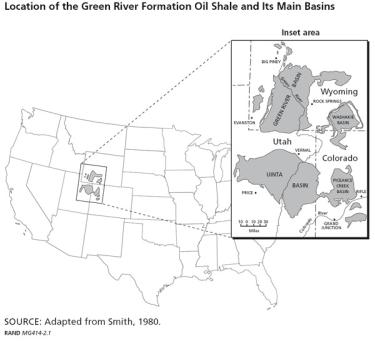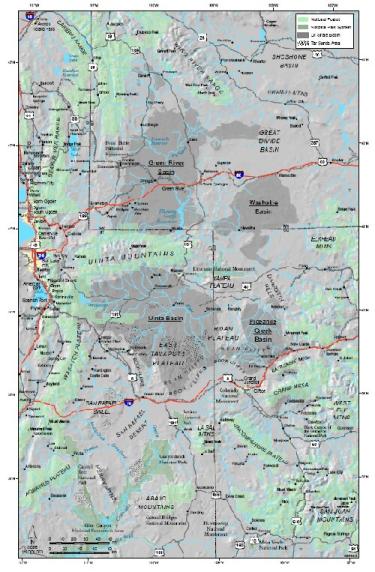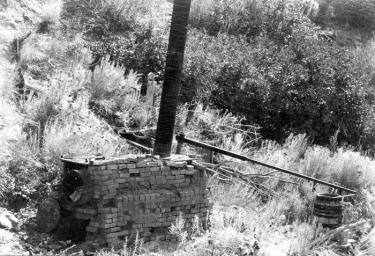Welcome to Shale Country
What is Oil Shale?
The Rock that Burns
On the Western Slope of Colorado’s Rocky Mountains, local lore tells of an early settler named Mike Callahan who built his home in the shadow of the cliffs along Parachute Creek in 1882. He cut and assembled sturdy local pines into a log cabin. To heat his new home, he built a fireplace and chimney out of the abundant and easily-quarried rocks he found on nearby slopes. When his work was complete, he threw a housewarming party that turned into a tragically bad pun (some might say metaphor) when the fire he lit in the hearth quickly spread up through the mahogany-colored chimney rocks and set the entire house ablaze. 1
Although nobody told Mr. Callahan until it was too late, the dark-hued shale rocks found in pockets along the Western Slope were oil shale. Often referred to as the rock that burns, oil shale boasts a high concentration of petroleum-like kerogens that will ignite when exposed to enough heat.
The name is misleading. Oil shale, which is a convenient umbrella term for a variety of fine-grained and organic-laden sedimentary rocks, is not really oil at all. While it formed in prehistoric lakebeds in a process similar to oil, it has not (yet) been subject to enough heat and pressure to be transformed into a liquid state. Instead, it is bound with the rocks as a waxy solid.
Given a few million more years, the kerogens trapped in the Western Slope shale may become liquid oil. But an influential combination of energy companies and politicians – all responding to the energy demands of American citizens, we should remember – would prefer not to wait for nature to take its course. They are inclined to speed up the process with the application of human ingenuity.
What Oil Shale Is Not
The term oil shale is not the only confounding nomenclature in this arena. To people seeking to better understand the nation’s energy options, oil shale, shale oil, shale gas, and oil sands sound similar and can be confusing. However, it is important to understand their differences, because each resource is found in different geological conditions that require distinctive processes to extract and refine it to a usable fuel.
For more than a century, shale and other sedimentary rocks containing a significant portion of solid waxy kerogens have been known as oil shale. When heated, the kerogens are converted to a type of liquid oil that can be separated from the rock. Or, when the heating process is not controlled, the rock is liable to burn, as the unfortunate Mr. Callahan discovered.
Shale oil, meanwhile, is liquid crude oil found in the tiny pockets and spaces within shale rock formations. In the past, it was impractical for companies to recover such diffuse resources, particularly when they could tap larger underground reservoirs of oil instead. However, as the easily accessible oil reservoirs have become more scarce, energy companies have focused increasing attention on these “unconventional” deposits. Shale gas, which is often found with shale oil but is also produced on its own, is natural gas similarly trapped in tiny pockets diffused through the rock formation. Because the oil and gas are trapped in tight rock formations, these resources are sometimes referred to as tight oil and tight gas, names that would certainly help alleviate confusion if they were used more consistently.
Advances in two key technologies have allowed energy companies to cost-effectively extract shale oil and shale gas. Horizontal drilling technology allows companies to turn their wells underground to follow the oil and gas along the length of a shale layer instead of just straight down through it. And hydraulic fracturing, which involves injecting millions of gallons of water mixed with sand and chemicals down the well at high pressure, cracks the shale formation into a web of tiny fizzures that allow the tiny pockets of oil to flow to the well and be pumped out. These technologies are the driving force behind new oil booms in places like North Dakota and the significant expansion of natural gas development in places like the northeastern US and the flanks of the Rocky Mountains. Some oil shale developers envision using horizontal drilling in a similar manner to access shale deposits, but hydraulic fracturing is not currently part of any company’s oil shale plans.
Finally, oil sands are a mixture of clay, sand, water, and bitumen, a heavy black oil. Similar to oil shale, these sands usually require the application of heat to get the oil to flow, although the methods for applying that heat differ from proposed oil shale technologies. Oil sands are the focus of the ongoing oil boom in Alberta, Canada, from which the United States imports significant quantities of oil, and they are also found in US Shale Country throughout eastern Utah.
How Many Rocks Fit in a Barrel?
The most bountiful oil shale beds in the world lie in basins within the Green River Formation along the T-shaped border of Colorado, Wyoming, and Utah. The richest known deposits are located in Colorado’s Piceance Basin, an area of more than 1300 square miles just north of the city of Grand Junction and centered in Garfield and Rio Blanco Counties. (Say it right: The Piceance Basin, the site of all this excitement, is pronounced “PEE-ants” or “PEE-awnts” Basin, possibly as a derivation of a Ute Indian word for tall grass.)

The vast majority of these deposits, and more than 70% of all oil shale resources within the entire Green River Formation, lie beneath public land controlled by federal agencies such as the Bureau of Land Management and the US Forest Service. Estimates of the oil contained in the tristate Shale Country area range from 1.2 to 1.8 trillion barrels, with between 500 billion and 1 trillion located in the Piceance Basin alone. (One barrel equals 42 gallons of oil.) The United States consumes about 20.6 million barrels of oil total every day, of which roughly 75% is imported. Although not all of the oil in Shale Country will be recoverable, judicious estimates suggest that 800 billion barrels – more than triple Saudi Arabia’s proven reserves, enough to meet current US demand for over a century – might ultimately be extracted. 2
This 800-billion-barrel figure was put forward as a reasonable estimate by James Bartis, a widely recognized expert on the subject, in an influential report he wrote for the Rand Corporation in 2005. As with all estimates of oil reserves, and especially with those as tricky as oil shale, not everyone agrees. Some more recent estimates suggest that the amount of recoverable oil is upwards of 1.5 trillion barrels, and that the total resource represents 5 or even 8 times more than Saudi Arabia’s reserves. But the scope of the resource is, beyond question, already so large that a 200-billion-barrel bump makes little difference for broad social, economic, and environmental considerations addressed in this report. 3
The potential geopolitical and economic ramifications of such an immense resource for our nation and for the global community stagger the mind. With such a large prize waiting beneath the western flanks of the Rockies, oil shale promises to remain part of the nation’s thinking about energy sources into the foreseeable future.
The Answer to the Energy Crisis?
As the international oil markets continue to fluctuate precipitously, surging to historic highs before plummeting to prices that haven’t been seen in nearly a decade, frazzled consumers and their elected representatives have begun to view energy sources found close to home as a more reliable alternative to foreign suppliers. Interest in domestic unconventional fuels like oil shale has surged accordingly. The prospect of wringing billions of barrels of oil from these rocks is becoming a hot topic around the halls of government and the boardrooms of energy companies, not to mention the town halls of communities near the shale deposits and the meeting rooms of environmental organizations.

Fossil fuel resources like oil shale are considered unconventional in the sense that they are more difficult and more expensive to recover or produce than the free-flowing light crude oil that has been the industrialized world’s main energy source for the past century. Therefore they have remained largely untapped. Among the United States’ strategic unconventional fuel portfolio, oil shale is noteworthy because of the extraordinary size of the resource. Boosters promote these tremendous domestic oil shale reserves as a key part of the solution to the twin problems of declining worldwide crude oil production and increasing US dependence on foreign energy suppliers.
This is not the first time that the Western Slope’s oil shale fields have been promoted as an ace in the hole for national energy security. Twice in the twentieth century, the federal government encouraged mineral rushes intended to develop oil shale into a major energy resource. However, despite intense efforts, neither of these past booms unlocked the secret of turning oil shale into a viable commercial energy resource. Instead of establishing a new industry, both of these previous oil shale booms lead to excruciating busts that battered the communities of Shale Country, including a regionally devastating downturn in 1982.
History shows that interest in oil shale peaks when certain factors are met. We have simplified these factors into a simple formula that explains the three previous peaks in oil shale interest in the past century and can be used to predict when the next oil shale development cycle is near. The formula for an oil shale industry is:
(a+b+c) x = Oil Shale Industry
The three factors that most predict if oil shale is about to take off are: a) volatile oil prices; b) national security anxieties; c) active encouragement from the federal government. When these three issues occur interest in oil shale peaks. However, even when these three factors align, there is an X factor that determines if an actual oil shale industry will be created. The X factor for oil shale is sustainability. While the three previous peaks failed to produce a sustainable industry, current energy companies are working to create a process and product that can be marketed and sold for years to follow while sustaining the environment where they work.
Today it looks as though another oil shale development cycle is on the horizon, a prospect that local residents and concerned citizens throughout the nation regard with a mix of anticipation and apprehension. Energy companies are experimenting with a variety of new ways to unlock oil shale at public and privately owned sites throughout Shale Country. Like modern-day alchemists, they are looking for a way to turn rock into oil.
Early History
The promise of oil shale has been tantalizing people around the world since long before Mike Callahan accidentally publicized its existence on the Western Slope. 4 For centuries, people have heated shales to coax the oil out of the stone. Apothecaries and physicians in Austria used oil from shale for medicinal purposes as early as 1350. In England, where the word “petroleum” has been used to describe oil since the mid-fourteenth century, the first known patent for “a way to extract and make great quantities of pitch tarr and oyle out of a sort of stone” was issued in 1694. Commercial production, in which large quantities of shale were mined and heated in specialized ovens called retorts, began in France in the 1830s. Following the French lead and improving upon their methods, Scottish energy entrepreneurs initiated an oil shale industry around Edinburgh in 1850 that successfully operated into the 1960s.

In North America, Ute Indian words for “the rock that burns” indicate an early recognition of oil shale’s unique properties. The first small processing facility for shale was opened in Alberta, Canada, in 1815. By the eve of the US Civil War, more than 50 companies in Canada and the United States were retorting shale to distill oil from rocks (albeit none very successfully), most of which was used to produce kerosene. Mormon settlers founded the first known oil shale operation in the Rocky Mountain West, perhaps as early as 1855. These resourceful pioneers built a retort in a ravine near the small present-day town of Levan, Utah, about 100 miles south of Salt Lake City down Interstate 15. But the Drake oil strike in Pennsylvania in 1859 – and the subsequent birth of the modern American petroleum industry – quickly made oil shale an unprofitable venture in places that had access to its liquid counterpart. For a time, interest subsided. 5
Notes:
1 This anecdote is widely repeated. See, for example, “Digging into Shale’s Rocky Past,” Shale Country (Oct 1975): 20; Colorado Geologic Survey, “Oil Shale – Enormous Potential But…?” (PDF) RockTalk 7, no 2 (April 2004): 13-15. Today one of the peaks above Parachute is named after Callahan.
2 James T. Bartis, Rom LaTourrette, Lloyd Dixon, et al., Oil Shale Development in the United States: Prospects and Policy Issues (Santa Monica, CA: RAND Corporation, 2005), 5-9; BLM, “About Oil Shale, “Oil Shale and Tar Sands Leasing Programmatic EIS Information Center; US Energy Information Administration, “Petroleum Basic Statistics” (July 2008). The US currently produces just over 5 million barrels of oil a day from domestic sources, according to the EIA.
3 Bartis, Oil Shale Development in the United States, 5-9. Johnson, R.C., Mercier, T.J., and Brownfield, M.E., 2011, Assessment of in-place oil shale resources of the Green River Formation, Greater Green River Basin in Wyoming, Colorado, and Utah: U.S. Geological Survey Fact Sheet 2011–3063, 4 p. RAND Corporation estimates that 30-60% of the oil is recoverable which could mean as much as 1.5 billion barrels. Even using the conservative estimate of 800 billion there is still enough to oil nearly match the world’s proven oil reserves.
4 In addition to the specific citations listed in the notes below, information on the early history of the oil shale industry in this section was synthesized from Victor Clifton Alderson, The Oil Shale Industry (New York: Frederick A. Stokes Co, 1920), 15-45; Paul L. Russell, History of Western Oil Shale (East Brunswick, NJ: The Center for Professional Advancement, 1980), 5-114; Andrew Gulliford, Boomtown Blues: Colorado Oil Shale (Boulder, CO: University of Colorado Press, 2003), 1-84; David W. Miller, “The Historical Development of the Oil and Gas Laws of the United States,” California Law Review 51 (1963): 506-34; “Digging into Shale’s Rocky Past,” Shale Country (Oct 1975): 20; and Colorado Geological Survey, “Oil Shale – Enormous Potential But…?” (PDF) RockTalk 7, no. 2 (April 2004): 13-15.
5 Alderson, Oil Shale Industry, 26-7, 33-45; Russell, History of Western Oil Shale, 3, 85-7; “History,” Shale Country 5, no 4 special edition (1983), 2; European Academies Science Advisory Council, “A Study on the EU Oil Shale Industry – Viewed in the Light of the Estonian Experience” (May 2007), 15-6. Russell provides an excellent summary of what is known about the Mormon Retort.


